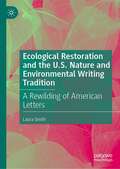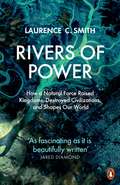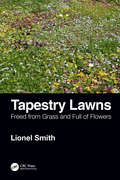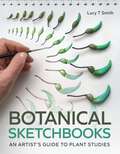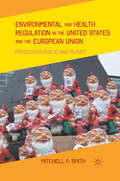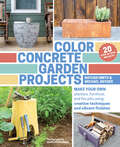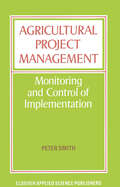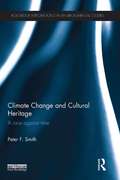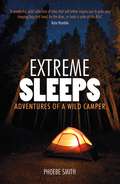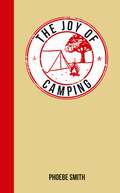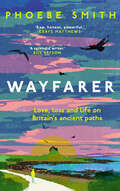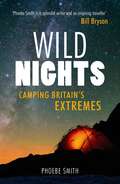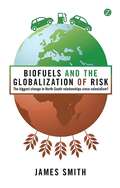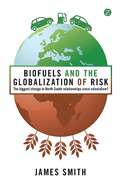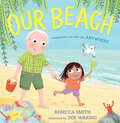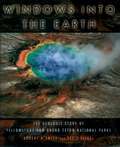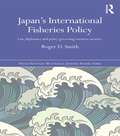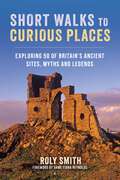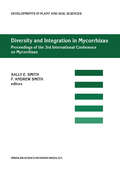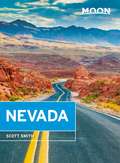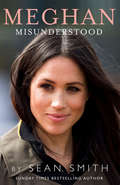- Table View
- List View
Ecological Restoration and the U.S. Nature and Environmental Writing Tradition: A Rewilding of American Letters
by Laura SmithThis book presents a critical history of the intersections between American environmental literature and ecological restoration policy and practice. Through a storying—restorying—restoring framework, this book explores how entanglements between writers and places have produced literary interventions in restoration politics. The book considers the ways literary landscapes are politicized by writers themselves, and by conservationists, activists, policymakers, and others, in defense of U.S. public lands and the idea of wilderness. The book profiles five environmental writers and examines how their writings on nature, wildness, wilderness, conservation, preservation, and restoration have variously inspired and been translated into ecological restoration programs and campaigns by environmental organizations. The featured authors are Henry David Thoreau (1817–1862) at Walden Pond, John Muir (1838–1914) in Yosemite National Park, Aldo Leopold (1887–1948) at his family’s Wisconsin sand farm, Marjory Stoneman Douglas (1890–1998) in the Everglades, and Edward Abbey (1927–1989) in Glen Canyon. This book combines environmental history, literature, biography, philosophy, and politics in a commentary on considering (and developing) environmental literature’s place in conversations on restoration ecology, ecological restoration, and rewilding.
Rivers of Power: How a Natural Force Raised Kingdoms, Destroyed Civilizations, and Shapes Our World
by Laurence C. Smith'As fascinating as it is beautifully written' JARED DIAMOND, Pulitzer Prize-winning author of Guns, Germs and SteelRivers, more than any road, technology or political event, have shaped the course of civilization. Rivers have opened frontiers, defined borders, supported trade, generated energy and fed billions. Most of our greatest cities stand on river banks or deltas, and our quest for mastery has spurred staggering advances in engineering, science and law. Rivers and their topographic divides have shaped the territories of nations and the migration of peoples, and yet - as their resources become ever more precious - can foster cooperation even among enemy states. And even as they become increasingly domesticated, they remain a formidable global force: these vast arterial powers promote life but are capable of destroying everything in their path.From ancient Egypt to our growing contemporary metropolises, Rivers of Power reveals why rivers matter so profoundly to human civilization, and how they continue to be indispensable to our societies and wellbeing.'Takes readers on a tour of the world's great rivers - past, present and future. The result is fascinating, eye-opening, sometimes alarming, and ultimately inspiring' Elizabeth Kolbert, Pulitzer Prize-winning author of The Sixth Extinction'A tour de force ... From Herodotus musing on the Nile to the dam makers of modern China, this is their story' Fred Pearce, author of When the Rivers Run Dry
Tapestry Lawns: Freed from Grass and Full of Flowers
by Lionel SmithSwathes of the human world are covered in ornamental grass lawns; they are the single most commonly encountered horticultural feature on the planet. Unfortunately, they are now often viewed as resource-draining green deserts due to the lack of plant and animal diversity, the need for frequent mowing and watering, and addition of lawn greening products to keep them looking at their best. It is a venerable horticultural feature that is essentially frozen in time, and with few alternatives to whet the appetite, the lawn has languished in its current grass-only format for decades. Until now. Tapestry lawns are a new, practically researched and timely development of the ornamental lawn format that integrates both horticultural practice and ecological science and re-determines the potential of a lawn. Mown barely a handful of times a year and with no need for fertilisers or scarifying, tapestry lawns are substantially richer in their diversity of plant and animal life compared to traditional grass-only lawns and see the return of flowers and colour to a format from which they are usually purposefully excluded. Tapestry Lawns: Freed from Grass and Full of Flowers traces the changes in the lawn format from its origins to the modern day and offers information on how and why the tapestry lawn construct is now achievable. It provides guidance on how to create and maintain a tapestry lawn of your own and champions the potential benefits for wildlife that can follow. Features Accessible and informative to all types of readers from academic to amateur Includes a refined and tested set of useful tapestry lawn plants Contains step-by-step instructions for creation and management methods of grass-free lawns Illustrated in full colour If you have ever thought about mowing your lawn much less, making it much more colourful and wildlife friendly, then this book will inform and guide you to create a perfect, grass-free lawn.
Tapestry Lawns: Freed from Grass and Full of Flowers
by Lionel SmithSwathes of the human world are covered in ornamental grass lawns; they are the single most commonly encountered horticultural feature on the planet. Unfortunately, they are now often viewed as resource-draining green deserts due to the lack of plant and animal diversity, the need for frequent mowing and watering, and addition of lawn greening products to keep them looking at their best. It is a venerable horticultural feature that is essentially frozen in time, and with few alternatives to whet the appetite, the lawn has languished in its current grass-only format for decades. Until now. Tapestry lawns are a new, practically researched and timely development of the ornamental lawn format that integrates both horticultural practice and ecological science and re-determines the potential of a lawn. Mown barely a handful of times a year and with no need for fertilisers or scarifying, tapestry lawns are substantially richer in their diversity of plant and animal life compared to traditional grass-only lawns and see the return of flowers and colour to a format from which they are usually purposefully excluded. Tapestry Lawns: Freed from Grass and Full of Flowers traces the changes in the lawn format from its origins to the modern day and offers information on how and why the tapestry lawn construct is now achievable. It provides guidance on how to create and maintain a tapestry lawn of your own and champions the potential benefits for wildlife that can follow. Features Accessible and informative to all types of readers from academic to amateur Includes a refined and tested set of useful tapestry lawn plants Contains step-by-step instructions for creation and management methods of grass-free lawns Illustrated in full colour If you have ever thought about mowing your lawn much less, making it much more colourful and wildlife friendly, then this book will inform and guide you to create a perfect, grass-free lawn.
Botanical Sketchbooks: An Artist's Guide to Plant Studies
by Lucy SmithThis inspirational guide explains how a botanical sketchbook can take many forms and hold different meanings. It shows how a sketchbook can be used as a workbook to study plants through drawing and painting in a variety of media. It includes examples of preliminary work for finished pieces, experiments in colour and exploration of plant anatomy, and shows how these studies can be made away from the pressure of creating the perfect, polished piece of final botanical artwork. It goes on to feature sketchbooks created for their own sake as a curated space for an artist to draw and record plants over a period of time, or a particular place.
Environmental and Health Regulation in the United States and the European Union: Protecting Public and Planet
by M. SmithDuring the first decade of the twenty-first century, the United States increasingly has relaxed its regulatory posture in the face of critical challenges to public health and the environment. This is true for regulation of recycling of end-of-life products, including autos and electronic components; potentially hazardous chemicals; and health claims on food labels. Coincidentally, the European Union has gravitated toward more restrictive regulation in these very same areas. How might we explain these diverging regulatory trajectories of the world s two largest market economies in an era of rising public awareness of dangers to the public and the planet? The explanation derives not from cultural differences in willingness to tolerate risk, but rather from distinctive regulatory tradeoffs - between environment and competitiveness in the United States and environment, competitiveness, and integration in the EU.
Color Concrete Garden Projects: Make Your Own Planters, Furniture, and Fire Pits Using Creative Techniques and Vibrant Finishes
by Nathan Smith Michael SnyderConcrete artisans Nathan Smith and Michael Snyder offer easy-to-follow directions for creating colorful concrete garden furniture and plant containers that are functional and stylish.
Agricultural Project Management: Monitoring and Control of Implementation
by Peter SmithI first became interested in the methods of planning the sequence and timing of jobs on large-scale development projects, as a field officer involved in planning and implementing mechanised farming schemes in Uganda in the mid-sixties. This interest was reinforced by experience of agro-industrial projects in both Nigeria and Iran, when it became obvious that the lax traditional methods of both planning and controll ing the implementation of agricultural and other rural development projects were very ineffective compared with those already in use in other disciplines. An extended spell as Resident Adviser on a World Bank project to strengthen planning and project management services in the agricultural sector in Sind Province, Pakistan, stimulated this interest further, and gave opportunities to develop the use of improved methods on some very complex schemes. This book summarises the experience gained in adapting critical path methods, well established in other fields, to Third World development projects, with their peculiar problems. It would not have been possible to reach this point without the help and stimulation of discussions with a large number of colleagues, includ ing John Joyce (then of Hunting Technical Services), Hatsuya Azumi (World Bank), and-particularly-Zaffar Sohrwardy and Akhtar Ali of Aarkays Associates in Karachi, during our work together. My thanks are also due to Yasin Mohammed, who typed most of the original draft; Anwar Mohammed and Irene Mills for final typing; and to my wife, Jill, for drawing the original figures.
Climate Change and Cultural Heritage: A Race against Time (Routledge Explorations in Environmental Studies)
by Peter F. SmithHistory reveals how civilisations can be decimated by changes in climate. More recently modern methods of warfare have exposed the vulnerability of the artefacts of civilisation. Bringing together a range of subjects - from science, energy and sustainability to aesthetics theory and civilization theory - this book uniquely deals with climate change and the ensuing catastrophes in relation to cultural factors, urbanism and architecture. It links the evolution of civilisation, with special emphasis on the dynamics of beauty as displayed in architecture and urbanism, to climate change. It then considers both the historic and predicted impacts of climate change and the threat it poses to the continued viability of human civilisation when survival is the top priority. This book gives students, researchers and professionals in architecture and sustainable design as well as anyone interested in the threat of global warming to civilisation, new insights as to what could be lost if action is not taken at a global level.
Climate Change and Cultural Heritage: A Race against Time (Routledge Explorations in Environmental Studies)
by Peter F. SmithHistory reveals how civilisations can be decimated by changes in climate. More recently modern methods of warfare have exposed the vulnerability of the artefacts of civilisation. Bringing together a range of subjects - from science, energy and sustainability to aesthetics theory and civilization theory - this book uniquely deals with climate change and the ensuing catastrophes in relation to cultural factors, urbanism and architecture. It links the evolution of civilisation, with special emphasis on the dynamics of beauty as displayed in architecture and urbanism, to climate change. It then considers both the historic and predicted impacts of climate change and the threat it poses to the continued viability of human civilisation when survival is the top priority. This book gives students, researchers and professionals in architecture and sustainable design as well as anyone interested in the threat of global warming to civilisation, new insights as to what could be lost if action is not taken at a global level.
Extreme Sleeps: Adventures of a Wild Camper
by Phoebe SmithGlobetrotter Phoebe Smith sets out to prove that outdoor adventures are available in the UK which rival anything found elsewhere in the world. In this sometimes scary and frequently funny journey around the country, Phoebe attempts to conquer its wildest places, defy her perceptions of the great outdoors and teach her about herself along the way.
The Joy of Camping: For Those Who Love the Great Outdoors (The\joy Of Ser.)
by Phoebe SmithThis pocket-sized miscellany, packed with tips on equipment, food, surviving bad weather and finding the right campsite, and with facts and stories from the world of camping, is perfect for anyone who knows the incomparable joy and adventure of pitching their tent under an open sky.
Wayfarer: Love, Loss And Life On Britain's Ancient Paths
by Phoebe SmithA woman’s tale of the transformative power of walking Britain’s ancient pilgrim paths ‘Raw, honest, powerful. I couldn't put it down.’ Cerys Matthews
Wild Nights: Camping Britain's Extremes
by Phoebe SmithBritain’s most famous wild camper, Phoebe Smith, is back. Battling whiteouts in Wales, facing monster waves in Suffolk and making camp on Britain’s highest mountain, Phoebe takes us on a series of inspirational expeditions into the wilderness as she quests to find the ultimate pitch.
Biofuels and the Globalization of Risk: The Biggest Change in North-South Relationships Since Colonialism?
by Professor James SmithBiofuels and the Globalization of Risk offers a fresh, compelling analysis of the politics and policies behind the biofuels story, with its technological optimism and often-idealized promises for the future. This essential new critique argues that investment in biofuels may reconfigure risk and responsibility, whereby the global South is encouraged to invest its future in growing biofuel crops, often at the expense of food, in order that the global North may continue its unsustainable energy consumption unabated and guilt-free. Thus, Smith argues, biofuels may constitute the biggest change in North-South relationships since colonialism.
Biofuels and the Globalization of Risk: The Biggest Change in North-South Relationships Since Colonialism?
by Professor James SmithBiofuels and the Globalization of Risk offers a fresh, compelling analysis of the politics and policies behind the biofuels story, with its technological optimism and often-idealized promises for the future. This essential new critique argues that investment in biofuels may reconfigure risk and responsibility, whereby the global South is encouraged to invest its future in growing biofuel crops, often at the expense of food, in order that the global North may continue its unsustainable energy consumption unabated and guilt-free. Thus, Smith argues, biofuels may constitute the biggest change in North-South relationships since colonialism.
Our Beach
by Rebecca SmithA brilliant and heart-warming story about the power of imagination and the special bond between grandparent and grandchild.
Windows into the Earth: The Geologic Story of Yellowstone and Grand Teton National Parks
by Robert B. Smith Lee J. SiegelMillions of years ago, the North American continent was dragged over the world's largest continental hotspot, a huge column of hot and molten rock rising from the Earth's interior that traced a 50-mile wide, 500-mile-long path northeastward across Idaho. Generating cataclysmic volcanic eruptions and large earthquakes, the hotspot helped lift the Yellowstone Plateau to more than 7,000 feet and pushed the northern Rockies to new heights, forming unusually large glaciers to carve the landscape. It also created the jewel of the U.S. national park system: Yellowstone. Meanwhile, forces stretching apart the western U.S. created the mountainous glory of Grand Teton National Park. These two parks, with their majestic mountains, dazzling geysers, and picturesque hot springs, are windows into the Earth's interior, revealing the violent power of the dynamic processes within. Smith and Siegel offer expert guidance through this awe-inspiring terrain, bringing to life the grandeur of these geologic phenomena as they reveal the forces that have shaped--and continue to shape--the greater Yellowstone-Teton region. Over seventy illustrations--including fifty-two in full color--illuminate the breathtaking beauty of the landscape, while two final chapters provide driving tours of the parks to help visitors enjoy and understand the regions wonders. Fascinating and informative, this book affords us a striking new perspective on Earth's creative forces.
Windows into the Earth: The Geologic Story of Yellowstone and Grand Teton National Parks
by Robert B. Smith Lee J. SiegelMillions of years ago, the North American continent was dragged over the world's largest continental hotspot, a huge column of hot and molten rock rising from the Earth's interior that traced a 50-mile wide, 500-mile-long path northeastward across Idaho. Generating cataclysmic volcanic eruptions and large earthquakes, the hotspot helped lift the Yellowstone Plateau to more than 7,000 feet and pushed the northern Rockies to new heights, forming unusually large glaciers to carve the landscape. It also created the jewel of the U.S. national park system: Yellowstone. Meanwhile, forces stretching apart the western U.S. created the mountainous glory of Grand Teton National Park. These two parks, with their majestic mountains, dazzling geysers, and picturesque hot springs, are windows into the Earth's interior, revealing the violent power of the dynamic processes within. Smith and Siegel offer expert guidance through this awe-inspiring terrain, bringing to life the grandeur of these geologic phenomena as they reveal the forces that have shaped--and continue to shape--the greater Yellowstone-Teton region. Over seventy illustrations--including fifty-two in full color--illuminate the breathtaking beauty of the landscape, while two final chapters provide driving tours of the parks to help visitors enjoy and understand the regions wonders. Fascinating and informative, this book affords us a striking new perspective on Earth's creative forces.
Japan's International Fisheries Policy: Law, Diplomacy and Politics Governing Resource Security (Nissan Institute/Routledge Japanese Studies)
by Roger D. SmithFew nations rely upon the ocean as much as Japan for livelihood, culture and transport. The seas have long played a vital role for the Japanese, helping to support the economic and social life of a nation that possesses few resources and little arable land, and sustain a population that has nearly tripled in the last century. Fish are a distinctive feature of the Japanese diet, constituting nearly half of all animal protein consumed – the highest rate in the world. The industry itself has provided an impetus for coastal community growth and national economic development over the past century, while fisheries have worked their way into Japanese culture and customs, serving as a dominant symbol in traditional arts and folklore. This book explores the overarching rationale that motivated Japanese international fisheries policy throughout the post-war period until today, highlighting the importance of international fisheries to Japan and the stature this resource has occupied as a national interest. It provides a comparative view of Japanese foreign policy at various ocean conferences, treaty negotiations, bilateral diplomatic initiatives and other maritime relations that constitute ocean policy over half a century, and investigates the domestic constituents of national policy. Roger Smith argues that the rationale for international fisheries policy may be best viewed as deriving from Japan’s unique defence strategy for its national interests: comprehensive security. Encompassing non-military elements and most importantly defence of economic interests, Japan’s international fisheries policy provides an interesting case study of how comprehensive security is conceptualised and carried out. Taking a broad view of Japan’s international fisheries policies from 1945 to the present, this book highlights the key trends in policy motives and means throughout the post-war period. As such, it will be of great interest to students and scholars of Japanese studies, international and environmental law, resource management and international relations, as well as to policy makers working in the field.
Japan's International Fisheries Policy: Law, Diplomacy and Politics Governing Resource Security (Nissan Institute/Routledge Japanese Studies)
by Roger D. SmithFew nations rely upon the ocean as much as Japan for livelihood, culture and transport. The seas have long played a vital role for the Japanese, helping to support the economic and social life of a nation that possesses few resources and little arable land, and sustain a population that has nearly tripled in the last century. Fish are a distinctive feature of the Japanese diet, constituting nearly half of all animal protein consumed – the highest rate in the world. The industry itself has provided an impetus for coastal community growth and national economic development over the past century, while fisheries have worked their way into Japanese culture and customs, serving as a dominant symbol in traditional arts and folklore. This book explores the overarching rationale that motivated Japanese international fisheries policy throughout the post-war period until today, highlighting the importance of international fisheries to Japan and the stature this resource has occupied as a national interest. It provides a comparative view of Japanese foreign policy at various ocean conferences, treaty negotiations, bilateral diplomatic initiatives and other maritime relations that constitute ocean policy over half a century, and investigates the domestic constituents of national policy. Roger Smith argues that the rationale for international fisheries policy may be best viewed as deriving from Japan’s unique defence strategy for its national interests: comprehensive security. Encompassing non-military elements and most importantly defence of economic interests, Japan’s international fisheries policy provides an interesting case study of how comprehensive security is conceptualised and carried out. Taking a broad view of Japan’s international fisheries policies from 1945 to the present, this book highlights the key trends in policy motives and means throughout the post-war period. As such, it will be of great interest to students and scholars of Japanese studies, international and environmental law, resource management and international relations, as well as to policy makers working in the field.
Short Walks to Curious Places: Exploring 50 of Britain's Ancient Sites, Myths and Legends
by Roly SmithEmbark on an extraordinary journey through the British countryside, leading to mysterious sites, ancient wonders and legendary landscapes to uncover 50 of the most intriguing walks in Britain. Discover the Green Chapel of Arthurian legend deep in the Staffordshire moorlands. Take a magical stroll through the fairytale forest of Wistman's Woods on Dartmoor. Marvel at the surreal rock formations of Brimham Rocks in Yorkshire, or spot the Hogwarts Express crossing the Glenfinnan Viaduct in the Scottish Highlands. With each walk ranging from two to eight miles in length and featuring beautiful photography, helpful directions and useful information, this book guarantees captivating experiences for walkers of all abilities, whether you're a casual stroller or seasoned hiker. Short Walks to Curious Places is your key to unlocking the secrets of the British countryside. With every step, you'll uncover the stories that shaped these extraordinary landscapes. Get ready to explore, discover and be enchanted by the wonders that lie just beyond the beaten path.
Diversity and Integration in Mycorrhizas: Proceedings of the 3rd International Conference on Mycorrhizas (ICOM3) Adelaide, Australia, 8–13 July 2001 (Developments in Plant and Soil Sciences #94)
by Sally E. Smith F. Andrew SmithThis book is highly recommended on the basis of the following points: - The editors are highly regarded in the field of mycorrhizal biology and one is co-author of the most comprehensive textbook on mycorrhizas; - Chapters by international experts based on invited presentations at the 3rd International Conference on Mycorrhizas, supplemented by invited chapters on special topics; - Mycorrhizas are being increasingly recognised as ubiquitous plant/fungal symbioses, with the potential to influence the function and ecology of around 90% of all land plants; perhaps the most common and also ancient terrestrial symbioses in existence; - This book has a broad coverage of biology of symbioses between mycorrhizal fungi and plants, especially ecto- and arbuscular mycorrhizas (other recent texts have focused mainly on arbuscular mycorrhizal symbioses); - Forward-looking review chapters by keynote speakers including an overview of research challenges for the future; - Up-to-date research focus; - Coverage includes: molecular diversity and detection of mycorrhizal fungi; cellular and molecular interactions between the symbionts; physiology of the interactions; implications of the symbioses for ecosystem processes, including agriculture; - Several complementary chapters on some topics, ensuring that different perspectives are presented (recent edited volumes have had a smaller group of authors and hence narrower focus); - Readership from advanced undergraduate students in biology (particularly plant science), postgraduate students and researchers in universities and government agencies.
Moon Nevada (Travel Guide)
by Scott SmithWhether you're an adventure junkie, road-tripper, or card shark, Nevada has something for you. Pull off the perfect trip to the Silver State with Moon Nevada. Inside you'll find:Strategic itineraries for road-trippers, campers, skiers, and moreThe best road trips through Nevada, from three days on "the loneliest road in America" to a week covering Death Valley and the Extraterrestrial Highway, plus detailed information on travel times, distances, and directionsThe top sights and unique experiences: Explore caves and glaciers at Great Basin National Park, or go fishing, swimming, or boating on Lake Tahoe or Lake Mead. Marvel at the Hoover Dam, camp at a secluded alpine lake, and experience the authentic Wild West in a ghost town saloon. Try your hand at a slot machine and eat your way through an epic Las Vegas buffet, or visit one of Nevada's major festivals and shop for local turquoise jewelry in a Gold Rush townLocal tips from longtime Nevadan Scott Smith on where to stay, when to go, and how to get around, plus advice for families with children and travelers with disabilitiesFull-color photos and detailed maps throughoutThorough background information on the landscape, climate, wildlife, and local cultureFocused coverage of Reno, Las Vegas, Death Valley, Tahoe, Central Nevada, Elko, the Ruby Mountains, and moreWith Moon Nevada's practical tips and local insight, you can plan your trip your way.Spending more time at the lake? Try Moon Tahoe. Headed to the parks? Try Moon Yosemite National Park or Moon Death Valley National Park.
Meghan Misunderstood
by Sean SmithMeghan Misunderstood is a pioneering book that sets the record straight on the most talked about, unfairly vilified and misrepresented woman in the world.
